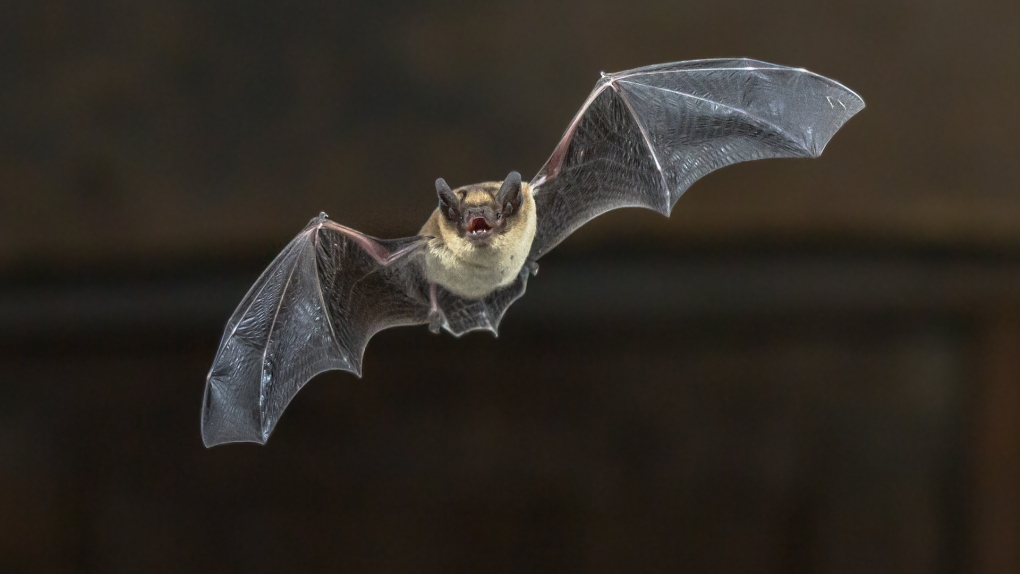Ontario's first domestic case of human rabies since 1967 confirmed in Brant County
 A bat is seen mid-flight in this generic image from Getty. (Source: Getty Images)
A bat is seen mid-flight in this generic image from Getty. (Source: Getty Images)
An Ontario resident remains in hospital after testing positive for rabies.
In a release shared on Friday, the Brant County Health Unit said they believe the person was exposed to the illness while in the Gowganda area of the Timiskaming region.
Rabies is a viral infection that causes brain and spinal cord inflammation. It usually spreads to humans through the saliva or mucous of an infected animal, such as a bat, skunk, fox or raccoon. According to the World Health Organization (WHO): “Once the virus infects the central nervous system and clinical symptoms appear, rabies is fatal in 100 per cent of cases.”
Until now, there has never been a confirmed case of rabies in a Brant County resident.
Nationwide, there have only been 26 known cases of rabies in humans since reporting began in 1924.
“Our heartfelt thoughts are with this individual and their loved ones during this incredibly difficult time,” Dr. Rebecca Comley, the county’s medical officer of health, said via a release. “Rabies, though rare, is a serious virus in humans. If you have direct contact with any animal known to carry rabies, you should seek immediate medical attention.”
Ontario’s Chief Medical Officer of Health also issued a statement on Friday afternoon.
“The illness is suspected to have been acquired from direct contact with a bat in Ontario. To ensure privacy for the family, no further information about the individual will be released,” Dr. Kieran Moore said.
The WHO says the incubation period for rabies is typically two to three months, but can vary based on viral load. Initial symptoms can include fever, pain, unusual or unexplained tingling, pricking or burning sensations at the wound site. Once the virus begins to move to the central nervous system, progressive and fatal inflammation of the brain and spinal cord develops.
Anyone who comes into direct contact with a bat, even if there is no visible bite or scratch marks, should seek immediate medical attention and begin a series of rabies vaccine doses. It’s also important to thoroughly wash the area with soap and water as soon as possible.
Although there has never been a documented case of human-to-human rabies transmission, family members and other close contacts of the patient are being assessed and will be offered post-exposure prophylaxis as needed.
CTVNews.ca Top Stories

Donald Trump says he urged Wayne Gretzky to run for prime minister in Christmas visit
U.S. president-elect Donald Trump says he told Canadian hockey legend Wayne Gretzky he should run for prime minister during a Christmas visit but adds that the athlete declined interest in politics.
Historical mysteries solved by science in 2024
This year, scientists were able to pull back the curtain on mysteries surrounding figures across history, both known and unknown, to reveal more about their unique stories.
King Charles III focuses Christmas message on healthcare workers in year marked by royal illnesses
King Charles III used his annual Christmas message Wednesday to hail the selflessness of those who have cared for him and the Princess of Wales this year, after both were diagnosed with cancer.
Mother-daughter duo pursuing university dreams at the same time
For one University of Windsor student, what is typically a chance to gain independence from her parents has become a chance to spend more time with her biggest cheerleader — her mom.
Thousands without power on Christmas as winds, rain continue in B.C. coastal areas
Thousands of people in British Columbia are without power on Christmas Day as ongoing rainfall and strong winds collapse power lines, disrupt travel and toss around holiday decorations.
Ho! Ho! HOLY that's cold! Montreal boogie boarder in Santa suit hits St. Lawrence waters
Montreal body surfer Carlos Hebert-Plante boogie boards all year round, and donned a Santa Claus suit to hit the water on Christmas Day in -14 degree Celsius weather.
Canadian activist accuses Hong Kong of meddling, but is proud of reward for arrest
A Vancouver-based activist is accusing Hong Kong authorities of meddling in Canada’s internal affairs after police in the Chinese territory issued a warrant for his arrest.
New York taxi driver hits 6 pedestrians, 3 taken to hospital, police say
A taxicab hit six pedestrians in midtown Manhattan on Wednesday, police said, with three people — including a 9-year-old boy — transported to hospitals for their injuries.
Azerbaijani airliner crashes in Kazakhstan, killing 38 with 29 survivors, officials say
An Azerbaijani airliner with 67 people onboard crashed Wednesday near the Kazakhstani city of Aktau, killing 38 people and leaving 29 survivors, a Kazakh official said.

































